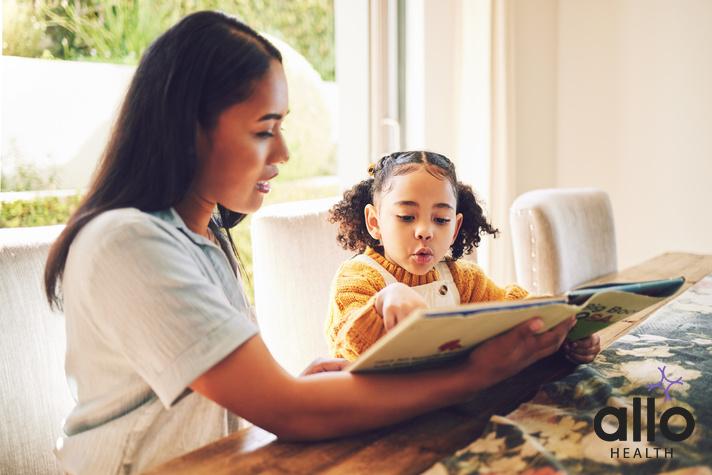A Guide To Teaching Young Girls About Safe Sex

Allo Health is dedicated to personalized well-being, offering support and trusted information tailored to individual health goals. The platform emphasizes human-generated content, led by a distinguished medical team of experts, including physicians and sexual health specialists. Their commitment to credibility involves rigorous fact-checking, authoritative research, and continuous updates to ensure accurate, up-to-date information. Allo Health's unique approach goes beyond conventional platforms, providing expert-led insights and a continuous commitment to excellence, with user feedback playing a crucial role in shaping the platform's authoritative voice.

Dr. Aswathi P T earned her MBBS degree and completed her internship at Government Medical College, Kozhikode, and possess diverse professional background spanning 3.5 years. Her experience includes a wide range of healthcare settings, including health centers, hospitals, and teleconsultation services.
Why This Was Upated?
Our experts continually monitor the health and wellness space, and we update our articles when new information became available.
Updated on 20 November, 2023
- Article was updated as part of our commitment to diversity, equity, and inclusion.

"The following blog article provides general information and insights on various topics. However, it is important to note that the information presented is not intended as professional advice in any specific field or area. The content of this blog is for general educational and informational purposes only.
Book consultation
The content should not be interpreted as endorsement, recommendation, or guarantee of any product, service, or information mentioned. Readers are solely responsible for the decisions and actions they take based on the information provided in this blog. It is essential to exercise individual judgment, critical thinking, and personal responsibility when applying or implementing any information or suggestions discussed in the blog."
When it comes to sex, it’s important that girls are equipped with the right knowledge to make informed decisions about their bodies. It’s never too early to begin educating your daughter about safe sex, as the earlier she learns, the more well-prepared she’ll be when the time comes. In this article, we’ll explore the fundamentals of safe sex for young girls, including the risks of unsafe sex, and what to do to ensure she is protected from STIs/STDs and unwanted pregnancy.
At What Age Should Young Girls Be Taught About Sex?
The appropriate age to start teaching young women about sex is a topic that has been widely debated among educators, parents, and experts. There is no one-size-fits-all answer, as it largely depends on the child’s maturity level, individual curiosity, and the cultural or religious beliefs of the family. However, it is generally agreed upon that comprehensive sex education should be introduced gradually and in an age-appropriate manner. Here’s a detailed breakdown of when and how sex education can be approached for young women:
Early Childhood (Ages 0-5):
At this stage, the focus is on teaching children about their bodies, boundaries, and appropriate touch. Children can be taught the names of body parts, including genitals, and should be encouraged to understand that certain parts of their body are private. This education helps them develop a sense of body autonomy and sets the foundation for understanding consent later on.
Elementary School (Ages 6-11):
- Basic Anatomy: Children should have a good understanding of human anatomy, including reproductive organs. This knowledge can be incorporated into general biology lessons.
- Puberty Education: Around the ages of 9-11, girls typically enter puberty. It’s crucial to educate them about the physical and emotional changes they will experience, including menstruation, breast development, and hormonal changes.
- Emotional and Social Aspects: Girls should be taught about emotions, relationships, friendships, and how to respect others’ boundaries. Discussions about consent and what constitutes appropriate behavior are important at this stage.
Middle School (Ages 12-14):
- Sexual and Reproductive Health: Detailed information about menstruation, pregnancy, contraception, and sexually transmitted infections (STIs) should be provided. Girls should also learn about different types of birth control methods and their effectiveness.
- Healthy Relationships: Focus on communication skills, building healthy relationships, understanding emotions, and recognizing signs of abusive behavior.
- Media Literacy: Teach girls to critically analyze media messages related to body image, relationships, and sexuality.
High School (Ages 15-18):
- Comprehensive Sex Education: Provide in-depth information about sexual health, including topics like sexual orientation, gender identity, sexual pleasure, and safe sex practices. Address common myths and misconceptions about sex.
- Decision-Making and Consent: Discuss the importance of making informed decisions about sex, respecting others’ boundaries, and understanding the concept of enthusiastic consent.
- Real-life Scenarios: Engage in discussions about real-life situations, peer pressure, and the consequences of risky behaviors.
- Support Services: Inform girls about where they can access reliable information, healthcare services, and counseling if needed.
Beyond High School:
- Continued Education: Encourage ongoing learning about sexual health, relationships, and consent throughout adulthood.
- Open Communication: Maintain open lines of communication between parents/guardians and young adults, so they feel comfortable discussing any concerns or questions they might have.
Sex education should always be age-appropriate, medically accurate, inclusive, and based on scientific evidence. It should also be tailored to the individual needs and maturity levels of the children involved. Additionally, involving parents in their child’s sex education and addressing cultural or religious concerns respectfully can create a supportive learning environment for young women.
The Importance Of Educating Young Girls On Sex
Educating young women about sex is of paramount importance for various reasons. A comprehensive and age-appropriate sex education equips girls with knowledge, skills, and attitudes that are essential for their overall well-being, safety, and healthy development. Here’s a detailed look at the importance of educating young girls on sex:
Knowledge Empowerment:
- Understanding Their Bodies: Sex education provides girls with accurate information about their reproductive anatomy, menstruation, and overall sexual health. This knowledge promotes body positivity and self-confidence.
- Puberty Awareness: Education about the physical and emotional changes during puberty helps girls navigate this transformative period with confidence and reduced anxiety.
Promoting Healthy Relationships:
- Consent and Boundaries: Girls learn about the importance of consent, setting boundaries, and recognizing signs of unhealthy relationships. This knowledge is crucial for their emotional well-being and safety.
- Communication Skills: Sex education teaches girls how to communicate effectively about their needs, desires, and concerns in relationships, fostering healthier interactions with others.
Preventing Sexual Abuse:
- Recognizing Abuse: Education equips girls with the ability to recognize and report any form of sexual abuse, ensuring their safety and well-being.
- Empowerment: Knowledge about personal boundaries and appropriate touch empowers girls to assert themselves, reducing vulnerability to abuse.
Sexual and Reproductive Health:
- Safe Sex Practices: Understanding safe sex practices, contraception, and STI prevention methods is crucial for girls’ reproductive health. It reduces the risk of unintended pregnancies and infections.
- Pregnancy Awareness: Accurate information about pregnancy, childbirth, and parenting prepares girls for future life choices, enabling them to make informed decisions.
Mental and Emotional Health:
- Reducing Stigma: Sex education helps reduce the stigma associated with sexual health concerns, fostering a more open and supportive society.
- Addressing Mental Health: Understanding the emotional aspects of relationships and sexuality promotes mental well-being and helps girls navigate the complexities of emotions related to intimate relationships.
Promoting Gender Equality:
- Empowering Choices: Comprehensive sex education encourages girls to pursue education, careers, and relationships based on their choices, promoting gender equality and dismantling stereotypes.
- Breaking Taboos: Education challenges cultural and societal taboos surrounding female sexuality, promoting a more inclusive and progressive society.
Preventing Unintended Pregnancies and STIs:
- Access to Information: Informed girls are more likely to make responsible decisions about sexual activity, reducing the rates of unintended pregnancies and the spread of STIs.
- Healthcare Access: Educated girls are more likely to seek timely medical care and advice, ensuring their sexual and reproductive health needs are met.
Life Skills and Decision-Making:
- Critical Thinking: Sex education fosters critical thinking skills, enabling girls to evaluate information, make informed decisions, and resist peer pressure.
- Life-Long Learning: The knowledge and skills acquired through sex education are life-long assets, contributing to personal growth and informed decision-making in adulthood.
Educating young girls about sex is a fundamental human right and an essential component of their overall education. It equips them with the knowledge and skills needed to make informed decisions, foster healthy relationships, and navigate the complexities of the modern world, ensuring their physical, emotional, and social well-being.

How To Appropriately Teach Young Girls About Sex?
Teaching young girls about sex is a sensitive and important task that requires careful consideration, empathy, and a focus on age-appropriate information. Here are some detailed guidelines on how to appropriately teach young girls about sex:
Start Early with Basic Concepts:
- Body Parts: Teach children the correct names for body parts, including genitals, from an early age. This helps establish a foundation of openness and comfort about their bodies.
- Private vs. Public: Explain the concept of private body parts and boundaries. Help them understand that certain parts of their bodies are private and that nobody should touch them without their consent.
Use Age-Appropriate Language:
- Simplify Language: Use simple and age-appropriate language when discussing sexual topics. Use words and phrases that are easy for the child to understand based on their age and level of comprehension.
- Answer Questions Honestly: Be honest and straightforward when answering their questions. Provide accurate information without unnecessary details.
Be Open and Approachable:
- Encourage Questions: Create an environment where girls feel comfortable asking questions about their bodies and sexuality. Encourage curiosity and provide honest, age-appropriate answers.
- Active Listening: Listen actively to their concerns and questions. Acknowledge their feelings and validate their emotions, creating a sense of trust.
Introduce Concepts Gradually:
- Puberty Education: When girls approach puberty (around ages 9-11), explain the physical and emotional changes they will experience, including menstruation, breast development, and hormonal changes.
- Reproductive System: Introduce basic concepts of the reproductive system, explaining how babies are conceived and born. Use age-appropriate diagrams or books to illustrate the process.
Teach About Healthy Relationships:
- Consent Education: Teach the importance of consent in all interactions, including physical contact. Explain what consent means and why it’s crucial in any relationship.
- Respect and Communication: Emphasize the values of respect, communication, and empathy in relationships. Teach girls how to express their feelings and how to recognize and respect the feelings of others.
Discuss Sexual Health and Safety:
- Safe Sex and Contraception: In adolescence, provide information about safe sex practices, contraception methods, and sexually transmitted infections (STIs). Emphasize the importance of protection and responsible choices.
- Online Safety: Discuss online safety, including the potential risks associated with sharing personal information online and the importance of setting boundaries in the digital world.
Address Peer Pressure and Media Influence:
- Media Literacy: Teach girls to critically analyze media portrayals of relationships, beauty standards, and sexuality. Help them understand the difference between media representations and real-life experiences.
- Peer Pressure: Discuss peer pressure and help girls develop skills to resist negative influences. Encourage them to make decisions based on their values and beliefs.
Involve Parents and Guardians:
- Parental Involvement: Involve parents and guardians in the educational process. Provide resources and materials that parents can use to continue these conversations at home.
- Cultural Sensitivity: Respect cultural and religious beliefs. Provide information in a way that aligns with the family’s values while ensuring essential knowledge is still conveyed.
Promote Emotional Well-Being:
- Self-Esteem: Promote a positive body image and self-esteem. Encourage girls to appreciate their bodies and understand that they are more than just their physical appearance.
- Emotional Intelligence: Teach emotional intelligence, helping girls recognize and manage their emotions effectively.
Encourage Lifelong Learning:
- Continued Education: Encourage girls to continue learning about sexual health and relationships as they grow older. Provide resources and support for ongoing education and exploration.
Appropriate sex education for young girls involves creating a safe, open, and supportive environment where they can learn about their bodies, relationships, and sexuality at their own pace. It should be a continuous and evolving conversation that respects their individuality, promotes self-confidence, and equips them with the knowledge and skills to make informed decisions throughout their lives.

Frequently Asked Questions
(1) Why is it important to tеach young girls about safе sеx?
Tеaching young girls about safе sеx is crucial to еnsurе thеir physical and еmotional wеll-bеing. Providing accuratе information еmpowеrs thеm to makе informеd choicеs, rеducing thе risk of unintеndеd prеgnanciеs and sеxually transmittеd infеctions (STIs). Safе sеx еducation also promotеs hеalthy rеlationships basеd on mutual rеspеct and consеnt, laying thе foundation for a safеr and morе rеsponsiblе approach to intimatе intеractions.
(2) At what agе should safе sеx еducation bеgin for young girls?
Safе sеx еducation should start in thе еarly tееnagе yеars, around 12-14, whеn girls typically еntеr pubеrty. At this agе, thеy arе bеttеr ablе to grasp thе concеpts of safе sеx, contracеption, and STI prеvеntion. Howеvеr, it’s еssеntial to tailor thе information basеd on individual maturity lеvеls, еnsuring that thе contеnt is agе-appropriatе and undеrstandablе for еach girl.
(3) What topics should bе covеrеd whеn tеaching young girls about safе sеx?
Whеn tеaching young girls about safе sеx, it’s important to covеr a rangе of topics, including thе propеr usе of condoms and othеr contracеptivеs, undеrstanding STIs and thеir prеvеntion, thе importancе of rеgular tеsting, and thе significancе of opеn communication with partnеrs. Additionally, discussing thе еmotional aspеcts of rеlationships, consеnt, and thе importancе of sеlf-rеspеct еnhancеs thеir ovеrall undеrstanding of safе and hеalthy intеractions.
(4) How can parеnts and guardians support safе sеx еducation for young girls?
Parеnts and guardians play a vital rolе in supporting safе sеx еducation. Thеy can maintain opеn communication with thеir daughtеrs, еncouragе quеstions, and providе accuratе, rеliablе information. Crеating a safе and non-judgmеntal spacе for discussions hеlps girls fееl morе confidеnt about sееking guidancе. Additionally, parеnts can еnsurе accеss to hеalthcarе sеrvicеs, including confidеntial consultations, promoting rеsponsiblе sеxual hеalth practicеs.
(5) What arе thе long-tеrm bеnеfits of tеaching young girls about safе sеx?
Tеaching young girls about safе sеx has long-tеrm bеnеfits, including rеducеd ratеs of unintеndеd prеgnanciеs and STIs. It еmpowеrs thеm to makе rеsponsiblе dеcisions, fostеring hеalthiеr rеlationships and еmotional wеll-bеing. In thе broadеr contеxt, wеll-informеd girls grow into womеn who arе confidеnt advocatеs for thеir own sеxual hеalth, contributing to a sociеty that valuеs informеd choicеs, consеnt, and ovеrall sеxual wеll-bеing.






































